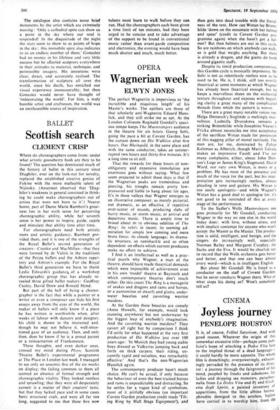BALLET
Scottish search
CLEMENT CRISP
Where do choreographers come from: under what artistic gooseberry bush are they to be found? The question has dominated much of the history of ballet in this century since Diaghilev, ever on the look-out for novelty, replaced the established creative genius of Fokine with the more malleable talent of Nijinsky. (Ansermet observed that 'Diag- hilev's weakness in general consisted in think- ing he could make choreographers out of artists that were not born to it'.) Nearer home, part of Dame Marie Rambert's great- ness lies in her sixth sense for perceiving choreographic ability, while her seventh sense is her power to inspire, guide, cajole and stimulate that ability time after time.
For choreographers need both artistic mots and artistic guidance; Rambert pro- vided them, and it is one of the strengths of the Royal Ballet's second generation of creators—Cranko and MacMillan—that they were formed by de Valois in the traditions of the Petipa ballets and the Ashton reper- tory and Ashton's example. For the Royal Ballet's third generation we have to thank Leslie Edwards's guidance,, of a workshop choreographic group that has already re- vealed three gifted ballet makers: Geoffrey Csuley, David Drew and Ronald Hynd.
But part of the hell of being a choreo- grapher is the fact that while a painter or a writer or even a composer can hide his first essays away from the eyes of the world, the maker of ballets will only know if a piece he has written is worthwhile when, after weeks of labour with dancers and designer, his child is shown to the interested and, though he may not believe it, well-inten- tioned gaze of an audience. Then, and only then, does he know if he is a proud parent or a reincarnation of Frankenstein.
These thoughts, and even darker ones, crossed my mind during Ploys, Scottish Theatre Ballet's experimental programme at The Place in London last week. I managed to see only an anaemic five of the six works on display; the failing common to them all seemed an absence of formal strength and choreographic vitality. They looked rootless and sprawling; that they were all desperately earnest is a matter of their creators' taste, but that they lacked pace and in some cases basic structural craft, and were all far too long, suggested to me that these five new
talents must learn to walk before they can run. Had the choreographers each been given a time limit of ten minutes, had they been urged to be concise and to ,take advantage of the support to be found in conventional music rather than avant-garde composition and electronics, the evening would have been much shorter and much, much better.


































 Previous page
Previous page